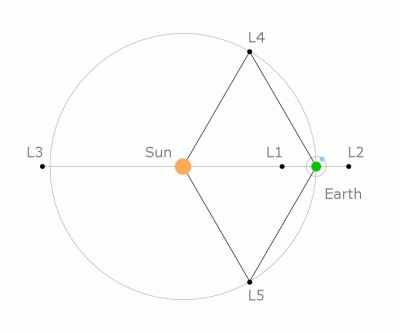Orbit/Navigation
Planck was carried into space on 14 May 2009, at 13:12:02 UTC, by an Ariane 5 ECA launcher, from the Guiana Space Centre, Kourou, French Guiana. Planck was launched together with ESA's Herschel spacecraft.
Within 30 minutes after launch, and about two minutes from each other, the two spacecraft were released and each placed on their individual escape trajectory toward L2, the second Lagrange point of the Sun-Earth system. Upon separation, Planck was spin stabilised at 1 rpm.
About six weeks after launch, following a set of trajectory control manoeuvres, Planck will reach its operational orbit: a Lissajous orbit with an average amplitude of about 400 000 km around the L2 point at a distance of around 1.5 million km from Earth in the anti-Sun direction.
The commissioning of the spacecraft is performed during the journey to L2 and is expected to last until the spacecraft reaches its operational orbit.
 |
|
Location of L2 (not to scale) |
At L2, Planck will perform a major manoeuvre to enter its Lissajous orbit about the Lagrange point, with the Sun-spacecraft-Earth angle limited to 15°. Lissajous orbits are the natural motion of a satellite around a collinear libration point in a two-body system and require less momentum change to be expended for station keeping than halo orbits, where the satellite follows a simple circular or elliptical path about the libration point.
Orbits about L2 are dynamically unstable; small departures from equilibrium grow exponentially with a time constant of about 23 days. Planck will use its propulsion system to perform orbit maintenance manoeuvres.
Choice of Orbit
The Planck spacecraft is spin stabilised at 1 rpm and normally operates with its spin axis pointing directly away from the Sun. The line-of-sight of the telescope is positioned at an angle of 85° to the spin axis and the instruments scan a circular sector of the celestial sphere with a radius of 85° once per spacecraft revolution. In order to view the celestial poles, the spin axis can be moved up to 10° away from the anti-Sun direction.
The anti-Sun pointing strategy reduces the effects of solar radiation to a minimum. However, the Earth and Moon can also be intense sources of both straylight and thermal radiation, and reducing their effects drives the choice of orbit. Near Earth orbits are eliminated mainly because the large thermal flux renders it extremely difficult to reach low temperatures at the focal plane of the telescope or to achieve the required thermal stability. The nearest possible far-Earth orbits are those around one of the Lagrangian points of the Earth-Moon system. These orbits, which share the lunar motion around the Earth, are rendered unsuitable by the fact that either the Earth or the Moon is often not very far from the telescope line-of-sight. Simulations indicate that if this type of orbit were chosen, at least 35% of the acquired data would have to be discarded due to poor thermal or straylight conditions, leading not only to lower sky coverage but also to a less efficient removal of systematic effects.
The optimum orbit, selected as a result of a trade-off among the various payload requirements, several spacecraft technical constraints (most importantly those related to communication with the ground station), and the transfer-to-orbit cost, is a Lissajous orbit around the L2 Lagrangian point of the Earth-Sun system. At this location the Sun, the Earth, and the Moon are all located behind the payload, where their undesirable effects are at the lowest possible level, both in terms of location and of flux. In addition, this is the only orbit in which the antennas, which provide Earth communication for the spacecraft, are also continuously pointed away from the payload, thereby minimizing the potential effects of RF interference.
As Planck orbits L2, it makes one rotation about the Sun per year. The spacecraft spin axis has to be rotated at the same rate in order to remain Sun pointed. This is achieved by making regular manoeuvres that will be combined with periodically moving the spin axis out of the ecliptic plane to obtain full sky coverage. In addition to keeping the spin axis pointed within 10° of the anti-Sun direction to keep the payload in shadow, it must also be kept within 15° of the Earth direction in order to keep the Earth in the field-of-view of the communications antenna.
